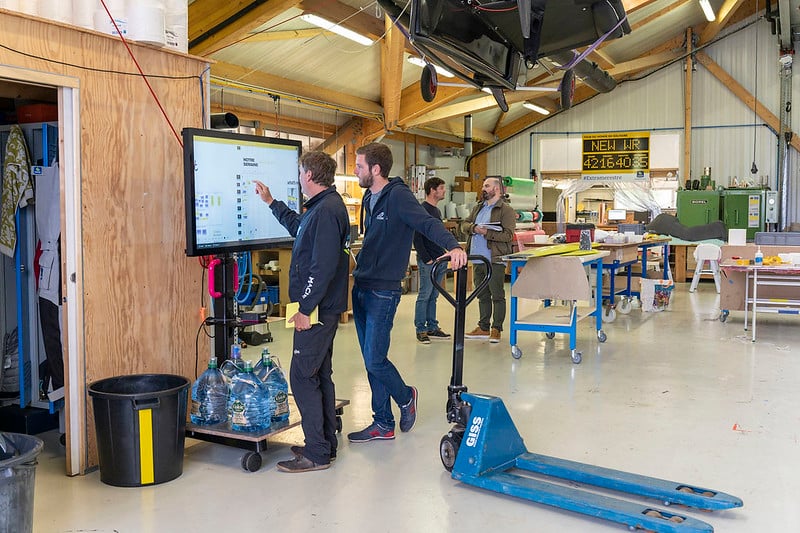How can cross-functional collaboration make everyone more effective?
Published on March 25, 2025
How can cross-functional collaboration make everyone more effective?
A cross-functional team brings together talent from different teams, with different and complementary skills, to work on a common project. With more agile and seamless communication, cross-functional collaboration can increase the efficiency of your business. Want to know how? Read on.
Have you ever wondered how many different people and teams you would need just to make a car? Just imagine. A research and development team to design the vehicle, designers to work on its shape, procurement teams to get certain parts and materials, factory operators to manufacture it and quality specialists to check compliance. That's a lot of people. It just goes to show that manufacturing a car is a very good example of cross-functional collaboration.
In some ways, every business project requires cross-functional collaboration, because every innovation, every new product or service, requires input from every team.
The main difficulty lies in the organization and communication between the different entities that need to collaborate. What's the point of making teams work together if everyone stays confined in their silo and nobody communicates in the end?
According to Behnam Tabrizi, Consulting Professor at Stanford University and thought leader on organizational and leadership transformation, 75% of cross-functional teams are dysfunctional. He identifies five main reasons for these problems, just three of which are enough to make a cross-functional team ineffective.
While issues relating to budget, deadlines and being customer-centric can occur in any project, the last two are an exception, because they are directly related to the specific nature of cross-functional collaboration.


Cross-functional teams bring together diverse talents and create super teams.
But getting to grips with cross-functional collaboration has the potential to make every team work better. Teams that use cross-functional collaboration are “super teams” to some extent. When it works, it helps to boost efficiency and reach new levels of commitment to ultimately achieve or exceed goals.
While cross-functional collaboration massively increases a team’s natural qualities, the issues it can face are just as big. In short, cross-functional collaboration at all levels of the business can be a very powerful asset, but also a great weakness.
So, how can you enable effective collaboration between different team members and ensure that everyone stays aligned with the company’s corporate goals?
In the first movie of the the Avengers series, the first time all the superheroes come together, it leads to a disaster. Basically, they destroy a US Army helicarrier. Why? Because despite their power, at that moment in history, they are not a team, just a group of people. And that doesn't work. It’s only when they realize they need each other that the situation improves and they can save the world. Phew.


And such a coordinated slowmo jump requires nothing else than teamwork.
It is not enough to just bring talents together. A cross-functional team can encounter the same issues - at its own level. Members of a cross-functional team are not used to working together – they may not even know each other. So these different individual talents need to be transformed into a single team. And to do this, making their collaboration meaningful is a priority.
The Forbes Technology Council recently addressed the issue. Sixteen of its members gave their strategies for building effective cross-functional teams. For Roman Taranov, founder and CEO of Ruby Labs, you need to “explain to members of the cross-functional team how their work will reach the company’s goals and even help them achieve their individual goals. It is especially important that they have full visibility to complete their projects successfully.”
Behnam Tabrizi goes even further: “Each member of a cross-functional team must make the project to which they are committed their priority.” He also recommends including the success - or failure - of cross-functional projects in the annual performance reviews of employees involved.


Successful cross-functional teams are those that make their work meaningful.
The team has to be set up properly to make it credible and concrete. But the thing that will transform your group of talented people into a real team is the interpersonal relationships between its members.
Would you want to give it your all for a colleague you know nothing about? Probably not. So you need to get to know each other. Both professionally and personally. On the one hand, this means recognizing the skills of others and their impact on the success of the project.
On the other, it is very helpful to get to know each other by talking about various things, especially non-work related topics. A study by Ron Friedman, PhD, an award-winning psychologist, confirms this. In his article 5 Things High-Performing Teams Do Differently, he demonstrates that in the highest-performing teams, colleagues spend more work time talking to each other. And their conversations deal with topics that have absolutely nothing to do with work, such as sports, books and family.
Who would have thought that talking about your favorite football team could help make your project a success?
One of the main issues for cross-functional teams is exchanging information. In a very (too?) traditional setup, there is a pre-determined information flow, where team members report to a project manager, who in turn gives information to a board member, who in turn can give it to an executive committee. This only results in making information less effective and less reliable.
To avoid being dysfunctional, teams working in the field must be able to pass on information directly. They are best placed to be able to share data, malfunctions, proposals for solutions to problems, etc. For it to be effective and to be used directly by everyone, this information needs to be organized on a shared and structured visual space.
This idea of one shared visual space has many advantages:
A company specializing in medical diagnostics has made it one of its keys success factors. Every day, in each of its factories, the teams record numerous indicators to monitor production (quality, cost, problems) and the quality of work life (motivation). Everything is grouped together on a dashboard created with a Board in Klaxoon's collaboration platform.
Every morning, afternoon and evening, the team members on site update the table. Thanks to a predetermined color code, the support and management teams can see at a glance what is working and what problems need to be solved during the day or in the medium term.


Effective cross-functional teams share relevant information directly.
Because it's the people directly in charge of projects who indicate their progress and stumbling blocks, this makes life much easier for all the teams. No matter which teams are involved, relevant information is shared, anywhere, anytime.
In addition to sharing information simply and effectively, you also need to get on the same page to ensure that all the stakeholders are moving in the same direction. This is where sync-up meetings come into their own.
Sync-up meetings are for team members working on the project. At every sync-up meeting, they share relevant information with the entire group so they can move forward as a team.
There are different kinds of sync-up meetings depending on your needs. For example, first of all, a daily meeting, to discuss the project’s progression quickly and effectively within the team. And a second meeting, which can be monthly, for long-term thinking and making strategic decisions.
Using both of these sync-up meetings, you will be able to track the cross-functional team's goals while staying aligned with the company's goals.
Therefore, MerConcept, the offshore racing team founded by the sailor François Gabart, decided to organize their company based on these ongoing discussions and this cross-functional collaboration using rituals and shared workspaces.
In recent years, racing boat design has become more complex. Materials, hull shape, hydrofoil design, hydraulic management and electronic steering are all joint endeavors, which require a very wide range of skills and dozens of trades to be in-sync at different times.


At MerConcept, cross-functional collaboration is now the norm across all sites.
And since 2019, the company has been transformed. Imagine 80 employees spread over numerous sites: in offices, in a huge boatyard, at the premises of various technical partners and at sea, offshore! Up to this point, each trade worked in sequence. François Gabart wanted to revolutionize this approach by maximizing interaction for the duration of the project: from the first sketch of the boat through to its launch. This approach breaks down silos and makes it easier for different trades and different teams to work together.
It is an approach that breaks down silos by facilitating work between different professions and teams. From workshop to workshop, the teams coordinate and share as much information as possible on Klaxoon's collaboration platform on a daily basis, in and out of meetings, and as each team progresses.
A vision defended by Thomas Normand, the CEO: “We managed to avoid working in silos. Now, when our teams find good solutions, they must be able to share them immediately, internally. Likewise, when they encounter problems, they must be able to find solutions, not in their group but by working cross-functionally. There's bound to be an answer somewhere at Merconcept, an answer based on all our years of experience.”
In short, all the people who contribute to the value chain collaborate effectively in a coordinated manner. Why? Because everyone participates and is committed to the joint project. This increases everyone's commitment and participation.
We told you that the car might well be a symbol of cross-functional collaboration. After all, it can be the trimaran as well!
Unlock your teamwork potential